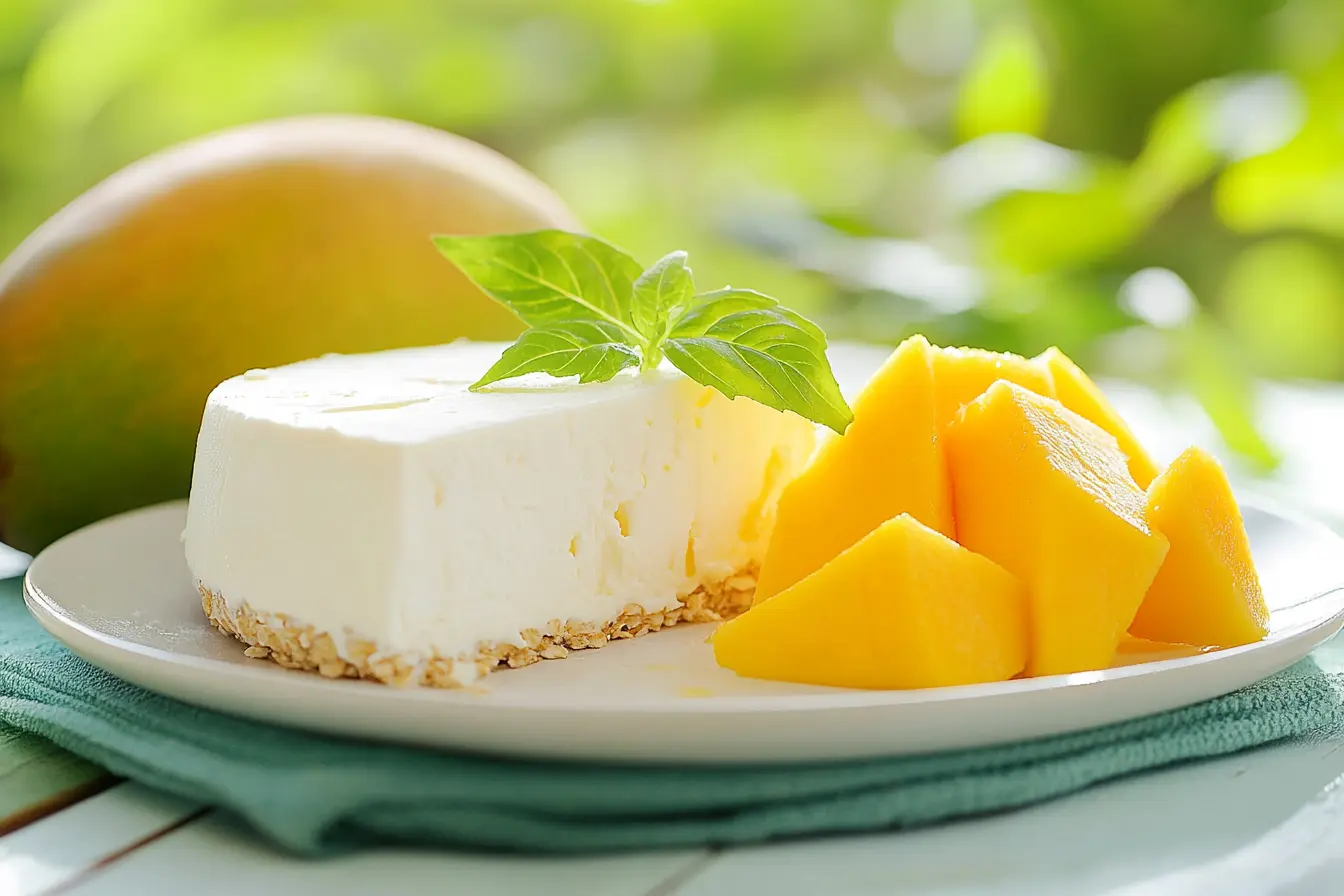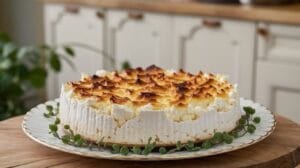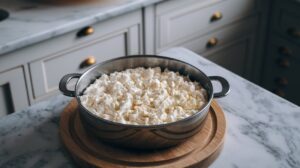When you first ponder what happens to cottage cheese when you bake it? you might imagine it transforming like mozzarella or cheddar. However, cottage cheese behaves quite differently under heat. This fresh cheese, crafted from curds separated from whey, comes packed with moisture and a mild, delicate flavor. Unlike aged cheeses that stretch into gooey ribbons, cottage cheese never melts in that classic sense. Instead, it softens, thickens, and becomes pleasingly creamy.
Because it isn’t aged, cottage cheese doesn’t contain the protein structures needed for stretchy melts. Instead, it undergoes a more subtle change, blending seamlessly with other ingredients. By baking cottage cheese, you can enhance dishes that require moisture and richness without overwhelming them. From savory casseroles to sweet breakfast bakes, understanding its heat-induced transformation can help you create balanced, delicious recipes.
This article will explore the science behind cottage cheese’s unique baking behavior, discuss ideal culinary applications, examine health advantages, and offer techniques for the best outcomes. By the end, you’ll know how to turn this simple, protein-packed dairy product into a culinary ally.
Table of Contents
ToggleA Quick History and Popularity of Cottage Cheese
Cottage cheese has long graced American tables as a high-protein, versatile option. Its fresh, clean taste and creamy texture made it a staple in both savory and sweet recipes. Over time, cooks learned that gently heating it in the oven yielded delightful textures that complemented everything from vegetable bakes to fruit-filled pastries. Understanding what happens to cottage cheese when you bake it? opens up a world of possibilities, allowing you to craft dishes that are lighter, more nutritious, and remarkably satisfying.
The Science Behind Baking Cottage Cheese
What Happens to Cottage Cheese When You Bake It? The Chemical and Physical Changes
When cottage cheese enters the oven, heat triggers several subtle shifts. Moisture begins to evaporate, causing the curds to tighten and thicken. Unlike melting cheeses known for their stringiness, cottage cheese becomes creamy and integrated rather than gooey. Temperature and baking duration play crucial roles. A moderate oven temp and gentle cooking time allow moisture to escape slowly, resulting in a velvety layer rather than a runny or rubbery texture.
Instead of transforming into long strands, cottage cheese’s proteins rearrange to form a custard-like consistency. This texture makes it perfect for dishes where you want richness without oily heaviness. Because it doesn’t behave like traditional melting cheeses, you gain control over the final mouthfeel of your baked recipe.
The Role of Moisture and Protein in Cottage Cheese Oven Transformation
Cottage cheese’s high moisture content sets the stage for its unique baking behavior. As water evaporates, the curds become denser and smoother. Proteins gently realign, thickening into a creamy matrix that supports other components in your dish. Additionally, variations in fat content influence outcomes. Full-fat cottage cheese leads to richer results, while low-fat versions create lighter textures.
Fat Content and Structure in Cottage Cheese Changes Under Heat
Fat acts as a tenderizing agent, ensuring baked cottage cheese doesn’t turn grainy. It balances moisture and protein bonds, producing a more indulgent consistency. However, even low-fat options maintain some creaminess, making them suitable for healthier recipes. By choosing the right type, you can tailor your dish’s final texture.
Ultimately, what happens to cottage cheese when you bake it? depends on the interplay of moisture, protein, and fat. This combination shapes cottage cheese into a versatile ingredient that can be used in everything from hearty lasagnas to decadent desserts.
Comparing Cottage Cheese to Other Cheeses
What Happens to Cottage Cheese When You Bake It? vs. Melting Cheeses
To understand what happens to cottage cheese when you bake it?, consider how it differs from melting cheeses like mozzarella or cheddar. Those cheeses stretch into strings because their proteins form elastic networks under heat. Cottage cheese, by contrast, lacks this network. Instead, it thickens into a creamy base that complements, rather than dominates, a dish.
With cottage cheese, you won’t achieve gooey layers. Instead, you get subtle moistness and a satisfying texture. This unique characteristic suits recipes where you want dairy richness without a heavy, oily surface.
Cottage Cheese vs. Ricotta, Cream Cheese, and Other Fresh Cheeses in Cottage Cheese Baking Effects
Ricotta and cottage cheese share similarities since both soften rather than melt. Yet, ricotta often starts smoother. Cottage cheese may need blending for certain dishes that require a silky finish. Cream cheese, on the other hand, melts into a smooth, uniform layer, whereas cottage cheese remains slightly more textured if not blended.
Farmer’s cheese and paneer, other fresh cheeses, stay firmer even when baked. Cottage cheese, conversely, leans toward creaminess, making it a great choice for enhancing moisture in baked goods.
Ideal Situations to Use Cottage Cheese Instead of Melting Cheeses in What Happens to Cottage Cheese When You Bake It?
Choose cottage cheese when you want added protein, a gentle dairy note, and creaminess without the oiliness of melted cheese. Lasagnas, casseroles, and baked desserts that benefit from moisture and tenderness shine with cottage cheese. Because it never transforms into a gooey layer, it’s perfect for recipes where a subtle creamy touch is more desirable than a stretchy topping.
By understanding how cottage cheese differs from other cheeses, you can confidently pick it for recipes that call for mild richness and balanced textures.
Savory Applications
Utilizing What Happens to Cottage Cheese When You Bake It? in Savory Dishes
Cottage cheese excels in savory baking, adding depth and creaminess. In lasagnas, it helps keep layers moist while boosting protein. In casseroles, cottage cheese eliminates the need for heavy cream, resulting in a lighter, more nutritious meal. Quiches and stuffed shells benefit from its subtle flavor and improved texture, ensuring the final dish feels luscious without being weighed down.
You can leave the curds intact for a rustic feel or blend them until smooth. Either way, cottage cheese adapts to your preferences. By leveraging what happens to cottage cheese when you bake it?, you gain a secret weapon that enhances your savory lineup.
Techniques for Savory Bakes with Cottage Cheese in Oven
If your cottage cheese seems too wet, draining it improves results. Mixing it with herbs, spices, sautéed veggies, or lean proteins creates flavorful fillings with minimal added fat. Layering cottage cheese between noodles or grains contributes creaminess to baked dishes that might otherwise turn dry.
Additionally, choosing ingredients that complement cottage cheese’s mild tang is key. Think spinach, mushrooms, or mild onions. Consider adding a small amount of melt-friendly cheese if you crave a hint of gooeyness.
Flavor Pairings and Seasonings to Enhance Cottage Cheese Transformation Under Heat
Cottage cheese pairs well with basil, dill, oregano, and garlic to create savory depth. A bit of Dairy Nutrition insight can help you understand its profile and choose seasonings that highlight its strengths. Balancing flavors ensures that every bite feels harmonious and rich. As you experiment, you’ll appreciate how cottage cheese subtly elevates your savory creations, offering moistness, protein, and a refined finish.
Sweet Baking Applications
Exploring What Happens to Cottage Cheese When You Bake It? in Desserts and Breakfast Treats
It’s not just savory dishes that benefit from this unique transformation. What happens to cottage cheese when you bake it? in sweet recipes is equally intriguing. Instead of relying on heavy creams, butter, or high-fat cheeses, cottage cheese offers protein, moisture, and a subtle tang that enhances many baked sweets.
Consider using it in cheesecakes, muffins, pancakes, or even custard-based desserts. Its naturally milder flavor and creamy finish mean you can lighten traditional indulgences without sacrificing taste. By blending cottage cheese until smooth, you create a base that mixes seamlessly with fruits, spices, and sweeteners, delivering treats that feel both satisfying and better balanced.
Tips for Incorporating Cottage Cheese in Sweet Recipes to Maximize Cottage Cheese Baking Effects
When adding cottage cheese to sweet batters, ensure it’s well-drained if very wet. Pureeing helps eliminate lumps, resulting in a silky texture that suits everything from berry-studded muffins to chocolate swirl cheesecakes. Adjust your sweeteners since cottage cheese isn’t as rich as cream cheese. A touch of honey or a mild syrup can add complexity.
For further insight on improving the nutrition of your baked goods, explore Healthy Baking Tips. By following such advice, you’ll learn to strike a balance between flavor and wholesomeness, making cottage cheese an ally in creating lighter desserts that still taste delightful.
Achieving Creamy Textures in Sweet Dishes with Cottage Cheese Changes Under Heat
As cottage cheese warms, it thickens into a texture that can mimic custard. Muffins remain tender and moist, and cheesecakes emerge fluffy and creamy yet not heavy. Incorporate fruits like blueberries, peaches, or raspberries to add brightness. A bit of cinnamon or vanilla extract lends depth. Nuts or a sprinkle of oats can supply crunch.
By experimenting with low and slow baking methods, you can achieve pudding-like textures or soft-set fillings. This versatility means cottage cheese broadens your baking horizons. Indeed, once you understand what happens to cottage cheese when you bake it?, you can craft desserts that feel less indulgent while still delivering on taste and texture.
Health and Dietary Perspectives
Health Benefits and Nutritional Advantages: What Happens to Cottage Cheese When You Bake It?
Cottage cheese offers notable nutritional perks. High in protein, it supports muscle maintenance and promotes satiety. Compared to heavier creams and cheeses, cottage cheese can lower the overall fat and calorie content of a dish. Its calcium and essential nutrients also contribute to a more balanced meal.
When baked, cottage cheese retains these benefits, giving you a wholesome component that enhances recipes without piling on unnecessary fats. Because it’s adaptable to various dietary styles, it allows health-conscious cooks to enjoy flavorful bakes while still meeting their nutritional goals.
Dietary Considerations and Adaptability in Cottage Cheese Oven Transformation
Cottage cheese fits seamlessly into many eating plans. Vegetarians appreciate its protein punch, while those following high-protein or moderate-fat diets find it a useful ingredient. Its mild flavor lets you pair it with whole grains, lean proteins, and nutrient-packed vegetables or fruits, making baked dishes both delicious and beneficial.
For more background on its production and origins, review Cheese Making Basics. Understanding how cottage cheese is created can help you appreciate its role in healthful, tasty cooking. Whether you’re reducing saturated fats, adding protein, or simply exploring new flavors, cottage cheese baked into meals can help you reach your dietary targets without feeling deprived.
Practical Tips, Common Mistakes, and Storage
What Happens to Cottage Cheese When You Bake It? – Practical Guidance
To achieve the best outcomes, pay attention to a few key tips. If your cottage cheese seems excessively watery, strain it before using. For smoother textures, blend it until velvety, especially in desserts or creamy fillings. Consider adjusting baking times or temperatures as needed. A gentle approach often preserves the cheese’s moisture and creamy consistency.
Mistakes to Avoid When Exploring Cottage Cheese Baking Effects
Don’t expect cottage cheese to behave like cheddar or mozzarella. Avoid over-baking, which can dry out your dish. Season savory recipes well to prevent blandness. If you desire a bit of gooeyness, pair cottage cheese with a melt-friendly cheese instead of trying to force a stretchy outcome.
Storing and Reheating Dishes with Cottage Cheese Changes Under Heat
After baking, store leftovers in airtight containers. Most cottage cheese-based dishes reheat gracefully at lower temperatures or in the microwave on reduced power. Many preparations taste just as good the next day, making them ideal for meal prep or time-saving weekday meals.
FAQs Section
Frequently Asked Questions About What Happens to Cottage Cheese When You Bake It?
This FAQ section addresses common concerns and helps clarify how cottage cheese behaves in the oven.
Can I Substitute Cottage Cheese for Oil in Brownies?
Yes. By blending cottage cheese until smooth, you can replace part of the oil. This substitution adds moisture, protein, and reduces fat. Adjust sweetness if necessary. The result is fudgy brownies with a slightly lighter texture.
Does Cottage Cheese Melt in Oven?
No, cottage cheese does not melt in the conventional sense. Instead, it softens, thickens, and becomes creamy. This makes it perfect for recipes that benefit from richness without gooey strands.
Why Do You Use Cottage Cheese in Baking?
Cottage cheese increases protein, moisture, and subtle flavor while cutting back on unnecessary fats. It creates creamy textures and complements both savory and sweet dishes. Using cottage cheese in baking supports balanced meals that still taste fantastic.
Conclusion
Final Thoughts on What Happens to Cottage Cheese When You Bake It?
By now, you understand that cottage cheese behaves differently under heat than traditional melting cheeses. Rather than producing long, stretchy pulls, it morphs into a creamy, integrated component that enhances the dishes you love. This unique transformation suits savory casseroles, lasagnas, quiches, and even sweet treats like cheesecakes or muffins.
Knowing what happens to cottage cheese when you bake it? empowers you to experiment with confidence. You can create balanced, protein-packed meals without relying on heavier creams or cheeses. The result is a wide range of baked recipes that feel nourishing, satisfying, and versatile. Through careful seasoning, blending, or layering, you’ll harness cottage cheese’s subtle magic to produce flavorsome results.
As you incorporate cottage cheese into your baked goods, remember that you’re not just adding dairy—you’re enhancing texture, nutrition, and the overall character of your food. Embrace its oven transformation, and enjoy the many ways it elevates your culinary endeavors.



